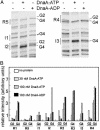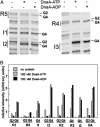Two discriminatory binding sites in the Escherichia coli replication origin are required for DNA strand opening by initiator DnaA-ATP
- PMID: 14978287
- PMCID: PMC365702
- DOI: 10.1073/pnas.0400340101
Two discriminatory binding sites in the Escherichia coli replication origin are required for DNA strand opening by initiator DnaA-ATP
Abstract
Initiation of DNA replication in eukaryotes, archea, and eubacteria requires interaction of structurally conserved ATP-binding initiator proteins and origin DNA to mediate assembly of replisomes. However, the specific requirement for ATP in the early steps of initiation remains unclear. This is true even for the well studied Escherichia coli replication origin, oriC, where the ATP form of initiator DnaA is necessary and sufficient for initial DNA strand separation, but the five DnaA-binding sites (R boxes) with consensus sequence 5'TGTGNAT/AAA bind both active ATP-DnaA and inactive ADP-DnaA with equal affinity. By using dimethyl sulfate footprinting, we recently identified two initiator-binding sites, I2 and I3, with sequence 5'TG/TGGATCAG/A. We now show that sites I2 and I3 preferentially bind DnaA-ATP and are required for origin unwinding. Guanine at position 3 determines DnaA-ATP preference, and changing this base to thymine at both I sites allows DnaA-ADP to bind and open oriC, although DNA strand separation is not precisely localized in the AT-rich region. These observations indicate that specific initiator binding sites within a replication origin can be important determinants of an ATP-dependent molecular switch regulating DNA strand separation.
Figures





Similar articles
-
Mechanism of origin unwinding: sequential binding of DnaA to double- and single-stranded DNA.EMBO J. 2001 Mar 15;20(6):1469-76. doi: 10.1093/emboj/20.6.1469. EMBO J. 2001. PMID: 11250912 Free PMC article.
-
Identification of the chromosomal replication origin from Thermus thermophilus and its interaction with the replication initiator DnaA.J Mol Biol. 2000 Jun 9;299(3):655-65. doi: 10.1006/jmbi.2000.3764. J Mol Biol. 2000. PMID: 10835275
-
Mutational analysis reveals Escherichia coli oriC interacts with both DnaA-ATP and DnaA-ADP during pre-RC assembly.Mol Microbiol. 2007 Oct;66(2):428-39. doi: 10.1111/j.1365-2958.2007.05930.x. Epub 2007 Sep 10. Mol Microbiol. 2007. PMID: 17850252 Free PMC article.
-
Initiation of DNA Replication at the Chromosomal Origin of E. coli, oriC.Adv Exp Med Biol. 2017;1042:79-98. doi: 10.1007/978-981-10-6955-0_4. Adv Exp Med Biol. 2017. PMID: 29357054 Review.
-
IHF and Fis as Escherichia coli Cell Cycle Regulators: Activation of the Replication Origin oriC and the Regulatory Cycle of the DnaA Initiator.Int J Mol Sci. 2023 Jul 18;24(14):11572. doi: 10.3390/ijms241411572. Int J Mol Sci. 2023. PMID: 37511331 Free PMC article. Review.
Cited by
-
Multiple DNA Binding Proteins Contribute to Timing of Chromosome Replication in E. coli.Front Mol Biosci. 2016 Jun 28;3:29. doi: 10.3389/fmolb.2016.00029. eCollection 2016. Front Mol Biosci. 2016. PMID: 27446932 Free PMC article. Review.
-
Replication Initiation in Bacteria.Enzymes. 2016;39:1-30. doi: 10.1016/bs.enz.2016.03.001. Epub 2016 Apr 20. Enzymes. 2016. PMID: 27241926 Free PMC article. Review.
-
Replisome Assembly at Bacterial Chromosomes and Iteron Plasmids.Front Mol Biosci. 2016 Aug 11;3:39. doi: 10.3389/fmolb.2016.00039. eCollection 2016. Front Mol Biosci. 2016. PMID: 27563644 Free PMC article. Review.
-
ClpAP is an auxiliary protease for DnaA degradation in Caulobacter crescentus.Mol Microbiol. 2016 Dec;102(6):1075-1085. doi: 10.1111/mmi.13537. Epub 2016 Oct 17. Mol Microbiol. 2016. PMID: 27667502 Free PMC article.
-
Fifty years after the replicon hypothesis: cell-specific master regulators as new players in chromosome replication control.J Bacteriol. 2014 Aug 15;196(16):2901-11. doi: 10.1128/JB.01706-14. Epub 2014 Jun 9. J Bacteriol. 2014. PMID: 24914187 Free PMC article. Review.
References
-
- Baker, T. A. & Bell, S. P. (1998) Cell 92, 295-305. - PubMed
-
- Bell, S. P. & Dutta, A. (2002) Annu. Rev. Biochem. 71, 333-374. - PubMed
-
- Liu, J., Smith, C. L., DeRyckere, D., DeAngelis, K., Martin, G. S. & Berger, J. M. (2000) Mol. Cell 6, 637-648. - PubMed
-
- Giraldo, R. (2003) FEMS Microbiol. Rev. 26, 533-554. - PubMed
Publication types
MeSH terms
Substances
Grants and funding
LinkOut - more resources
Full Text Sources
Molecular Biology Databases
Miscellaneous

